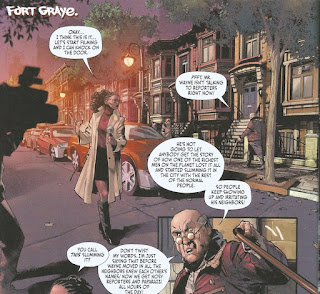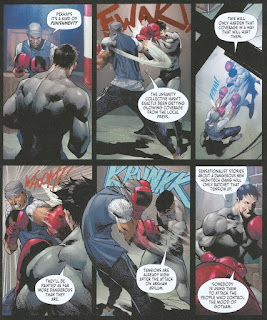Pick of the Brown Bag
March 5, 2021
by
Ray Tate
Welcome to the second part of the Infinite Frontier Marathon, I'm Ray Tate and for this leg I review Batman and Sensational Wonder Woman. For the impatient, you can drop down to the end of each review to see the special verdict. If you're upwardly on a mobile, check me out on Twitter: #PickoftheBrownBag.
Our story opens with Batman in the clutches of the Scarecrow. His mind turns back to how he ended up here. In part because he's attempting to combat Dr. Crane's fear toxin and for another because James Tynion believes he can write a film noir.
This could be the prologue of several such movies.
What was this woman's name? Ba-Ba-Barbara. Yes. That's it. Barbara. Barbara Gordon. Why did I forget that name? How could I? Barbara was a sizzling red-head with pins that went up to her ears and had a burning brain between them. The ears, not the legs.
Yeah, Babs Gordon. She used to be into costumes and handcuffs. Then some clown put an end to that and all the fun we had.
Anyway, it's such a ridiculous bit of pretentious writing. It would have been risible if it had any life to it. The narrative technique is never addressed again in the book. Furthermore, Tynion jumps around the point of view as much as he jumps around the scenery. So, what's the rationale?
The tale could have and should have started on page four with Batman tooling around Gotham's streets in the latest, and may I say, a gorgeous, version of the Batmobile.
Here we also get the best writing in the book. The interplay between Barbara and Batman about the car.
Batman's not out for a joy ride. He follows a group of art thieves in a flying apparatus that looks like part of the Micronauts line of toys.
I may have enjoyed this, but the art theft wasn't just to keep the felons in cycles and flying cars. The motive is far more esoteric.
Things pick up when the focus shifts back to the car-talk.
Batman pursues the art thieves above, while Babs addresses the ground situation. She calls in the Ghost Whisperer.
Sorry. I meant the Ghost Chaser.
Obviously that classic DC character the Ghost Maker. Are we sure Kurt Busiek didn't write this? Ghost Maker. Master Wyze. Terrible. Simply terrible.
Ghost Maker sure does like to "make an entrance," but it would have been better for the reader if he presented a card explaining just who the hell he is.
Batman deals with the art thieves quickly, but for some reason I'm just unsatisfied. The art thieves went out of their way to get some cool gadgets, and Batman just hits them. They deserved at least a bat taser, or bat bolas.
Batman joins up with the Ghost Maker, and they quickly retire to the townhouse (?) So, Ghost Maker is Batman's...houseboy? Seriously. I don't know who this guy is.
For no reason at all, Harley Quinn shows up late to the party. There's a lot of bleeped out profanity in Batman. Not just from Harley.
Letterer Clayton Clowes uses bats instead of @%& or redacted black out font. It's kind of cute. I just wish it were in a better story. One that stopped bouncing around like a kangaroo on acid.
Cut to Simon Saint introduced in Infinite Frontier. He's trying to push his Big Brother Magistrate Program on Mayor One-Eye, Jason Bard II Electric Boogaloo. See already that monicker is working out fine. Well, it brings a smile to my face, and that's all that matters.
Cut to Bruce Wayne's Townhouse. What the hell?
Apparently, Batman lost a lot of money. Though he still has enough to buy multiple properties with cave rebuilds.
Honestly. I'm sure that stellar artist Jorge Jimenez can draw a giant penny and dinosaur robot. Why do we need these townhouses with Bat Caves underneath?
At least in this scene, we find out about the Ghost Breaker.
No powers. Apparently spars with Batman.
Okay. How about a name?
Baman is Bruce Wayne, and you are...?
Fine. Screw you.
Finally, because James Tynion apparently hates the reader. We return to Mayor One-Eye and his relaxing in the Mayor's Mansion with a little companion called booze.
Cause that's what I want to see in a Batman comic book. A one-eyed jerk that I don't care one whit about sipping some...I don't know whiskey?
A beautifully illustrated Robin back up by artist Gleb Melnikov completes the page count of Batman.
The redesign on Robin's costume is fantastic, and Talia looks smashing.
I'm happy that Talia's doing something normal when Robin shows up. It's the only normalcy in Batman.
As to the story, well, it's a big info dump about how everybody's abandoned Robin or how he estranged himself. I never really cared that much about Damien Wayne and I still don't.
Batman is so dull it may as well be called Law & Order: Batman, but it's so pretty that I'll probably buy it as a hardback, if Jorge Jimenez sticks around, that is. Ignore if you don't like the art. Wait for the trade if you do.
Sensational Wonder Woman by comparison is the better book. Without comparison it's still not bad. First of all, it makes sense. Second, writer Stephanie Phillips only uses classic Wonder Woman history and classic, visually descriptive characters to relate the story.
Had you never heard of Hawkgirl, you'd still know her name, or come close. She's a lady with wings. Self-explanatory, right? Not so with the Ghost Scrounger.
Phillips opens with Diana trapped in a 1950s sitcom. She's married to a drip named Douglas.
Douglas bears a physical resemblance to a certain blonde pilot who has a penchant for crashing near Themyscira also known as Paradise Island.
So where is Wonder Woman really? Exactly where you expect her to be.
Predictability is the story's one fault. I mean, we knew Diana wasn't actually married to Douglas and likely in some kind of virtual prison. We've seen this kind of thing before. VR.5, made a series out of it.
Way ahead of its time. You needn't be Sherlock Holmes to deduce the culprit, but I'll keep the identity of Wonder Woman's jailer a secret. Phillips however doesn't cloud the captor's motive. There's no "the city is broken. Batman doesn't see it yet" sort of rubbish. The Wonder Woman villain is single-minded. He just dresses up his want with a different attack.
Phillips' story is a linear juxtaposition between only two settings: Diana's mind and reality. Phillips displays the problem. Introduces the guest-star. Then reveals the puppeteer behind the whole trap. The tale also benefits from a subtle depth.
Consider, Wonder Woman conceives of a man that looks like Steve Trevor but isn't Steve Trevor. She picks out his name at random and pins it to him like a boutonnière.
While under the influence of the mind probe, Diana conceived of a man she finds physically attractive, but that's as far as it goes.
Diana knows her Steve would not want her to be trapped in a 1950s sitcom. He wouldn't enjoy the social mores, any more than she would. In her heart, she knows that her Steve would always be a good man no matter where or in what time she meets him. Else why would she fall in love with him. So Douglas looks like Steve on the surface but will always be Douglas.
As Diana begins to question the virtual surrounds, artist Meghan Hetrick pays homage to the 1953 Chuck Jones, Michael Maltese short, "Duck Amuck."
Her art though dependent on elegant simple line work in addition exhibits a degree of complexity that's first felt and later subject for analysis.
In the 1950s setting, Hetrick captures the optics through one camera, one angle. As Diana shakes loose the bonds of nightmare, the visual becomes more dynamic.
Hetrick breaks the step of Republican Shangri-La. She presents close-ups, Off-kilter composition. The illusion of preternatural speed. Metaphor and drama. That kineticism grows with each turn of the page.
Simultaneously, Marissa Louise's colors become more substantial with nuanced shading and the like.
Notice how the art team now combine to not only make Wonder Woman more dimensional but also sensual. The wild hair. The confident look, the threat of her fists all convey what a 1950s sitcom husband would consider wanton. That's the point really. The confinement of sexuality. A woman must not appear sexy. She must be properly restrained and on the leash held by man. Subscribe.


























No comments:
Post a Comment